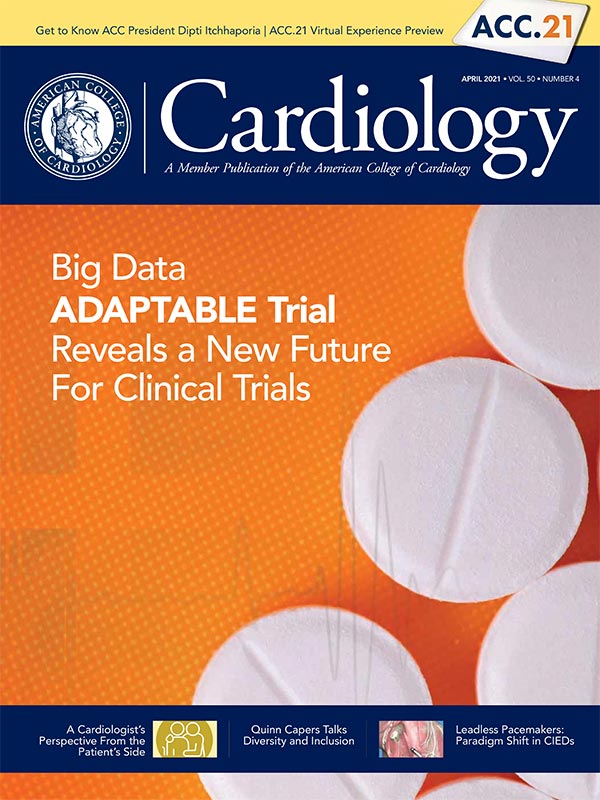Feature | Aortic Stenosis: Challenges For Shared Decision-Making

Expanding treatment options for an expanding population of patients with symptomatic aortic stenosis (AS) seems to be the norm for clinicians. But as transcathether and surgical aortic valve replacement (TAVR, SAVR) become more familiar for cardiovascular professionals, what are the challenges for working with patients for shared decision-making? What are the concerns for patients and what will better help them make treatment choices?
The ACC surveyed 157 currently practicing members in the U.S., across all tenure levels as well as interventional and non-interventional cardiologists, to better understand the challenges they face in working with their patients with symptomatic AS to understand their diagnosis and select their course of treatment.
For the majority (58%) of survey respondents, more than 20% of their patient population has been either diagnosed or treated for heart failure annually. And every year, about 10% of their heart failure patients have been either diagnosed or treated for symptomatic AS, said one-quarter of the cardiologists. One survey respondent, a co-director of a TAVR program, noted, "One of the great challenges is identifying patient's aortic valve stenosis earlier in their disease course," adding there are still too many patients with fairly advanced heart failure and aortic valve stenosis.
Clinician Perspectives on Discussing Treatment
Nearly 75% of cardiologists who treat AS discuss treatment options with their patients at the time of the diagnosis. The treatment options discussed most frequently are TAVR and SAVR (90% and 82%), compared with symptom management with medications (48%). Of note, interventional cardiologists are more likely than non-interventionalists to discuss medical therapy for AS (57% vs. 43%). Looking across tenures of cardiologists, early, mid and late career cardiologists are nearly equally likely to discuss TAVR and SAVR. However, differences are seen between interventional cardiologists and non-interventionalists for the frequency of discussing TAVR (100% vs. 87%) and SAVR (91% vs. 79%).
Who should decide which treatment is best for the patient? Although patient involvement in the decision is clearly acknowledged, cardiologists lean more toward the physician making the decision (mean, 6.29 on a scale of 0 to 10 points).
Physician vs. Patient Factors Affecting Choice of Treatment
For cardiologists, mortality risk is the most important consideration when determining the best treatment option, but for patients the key considerations are concerns about invasive treatment (by 56%) and the amount of time for recovery or away from work (by 50%).
Other concerns voiced by patients when seeking treatment for AS were that they would not be a candidate for a procedure because of age and/or other health conditions (by 28%), whether insurance would cover the procedure (by 26%), not having enough information to make a good decision about their treatment option (by 17%) or that the quality of the information did not allow them to make good decisions about their treatment. Reservations about newer, less proven treatment options was a concern for 11% and for 5% it was not having a heart valve disease doctor nearby.
The three most common patient misconceptions are that all the treatment options for AS essentially offer the same benefits/potential risks, believing they are a candidate for a treatment that is not an option, and an unrealistic expectation of outcomes based on conversations with others.
How to Improve Patient Education, Shared Decision-Making?
When it comes to patient education, one-half of the cardiologists use a 3D model, 43% use brochures or fact sheets and a third rely on online resources or videos and interactive content. The majority of cardiologists view their education resources as being very helpful for their conversations with their patients about AS treatment, and 53% also note that their patients with symptomatic AS patients are not well informed before they meet to discuss the treatment options.
CardioSmart: Resources to Help Your Patients
ACC's CardioSmart has created a range of tools to help patients understand aortic stenosis and their treatment options. From infographics explaining heart valve disease and TAVR, to decisions aids, to patient worksheets, each tool is designed to engage the patient and facilitate physician-patient dialogue to improve shared decision-making.
Bookmark CardioSmart.org for all your patient education needs.
Of the cardiologists responding, 59% believe that having a family member/friend attend the clinical visit to take notes and ask follow-up questions would better prepare patients to discuss their treatment options, and 53% think patient decision aids would be useful, along with preparing a list of questions to ask during the appointment (46%). By using these resources, patients would have a clearer understanding of the risks and benefits of treatment options, said 65%, and this would lead to a better quality discussion about treatment options (57%), as well as increase patient satisfaction (42%) and decrease confusion and nuance between the treatment options (34%).
What resources would improve the physician-patient dialogue and help patients understand their condition and treatment options? The top choice by the cardiologists is a patient-oriented description of TAVR vs. SAVR, followed by patient-oriented information about AS, print visual aids (images/charts/infographics), online videos, and online resources.
Print materials are the best format according to 61% of respondents and 54% say online education videos are the best; about 40% say other online education materials (infographics, etc.) and patient-physician discussion guides, and 25% say mobile apps.
One survey respondent commented that, "It's shocking how few educational resources are available to patients depending upon the marketplace, practice environment. ACC could do a lot to level the field." One cardiologist noted that many patients are underinsured with limited tech access, even though they are younger than 65 years.
Asking more questions during doctor's appointments and seeking treatment sooner are the two most common responses from roughly one-third of patients when asked what could have helped them with their decision-making. About 15% also say obtaining a second opinion would have also helped.
Post-procedure, the majority of patients said they were able to enjoy working around the house or yard (73%) and exercising (71%) again. Nearly one-third also listed spending more time with family and friends and returning to work, whether full- or part-time.
Clinical Topics: Cardiac Surgery, Cardiovascular Care Team, Diabetes and Cardiometabolic Disease, Heart Failure and Cardiomyopathies, Invasive Cardiovascular Angiography and Intervention, Prevention, Valvular Heart Disease, Aortic Surgery, Cardiac Surgery and Heart Failure, Cardiac Surgery and VHD, Acute Heart Failure, Interventions and Structural Heart Disease, Exercise
Keywords: ACC Publications, Cardiology Magazine, Patient Participation, Patient Satisfaction, Friends, Aortic Valve, Aortic Valve Stenosis, Medically Uninsured, Mobile Applications, Education, Distance, Decision Making, Follow-Up Studies, Transcatheter Aortic Valve Replacement, Exercise, Heart Failure, Motivation, Heart Valve Diseases, Risk Assessment, Referral and Consultation, Audiovisual Aids, Family, Decision Support Techniques, Insurance
< Back to Listings

